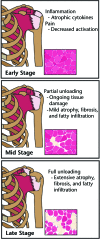Developmental Biology and Regenerative Medicine: Addressing the Vexing Problem of Persistent Muscle Atrophy in the Chronically Torn Human Rotator Cuff
- PMID: 26847008
- PMCID: PMC4858662
- DOI: 10.2522/ptj.20150029
Developmental Biology and Regenerative Medicine: Addressing the Vexing Problem of Persistent Muscle Atrophy in the Chronically Torn Human Rotator Cuff
Abstract
Persistent muscle atrophy in the chronically torn rotator cuff is a significant obstacle for treatment and recovery. Large atrophic changes are predictive of poor surgical and nonsurgical outcomes and frequently fail to resolve even following functional restoration of loading and rehabilitation. New insights into the processes of muscle atrophy and recovery gained through studies in developmental biology combined with the novel tools and strategies emerging in regenerative medicine provide new avenues to combat the vexing problem of muscle atrophy in the rotator cuff. Moving these treatment strategies forward likely will involve the combination of surgery, biologic/cellular agents, and physical interventions, as increasing experimental evidence points to the beneficial interaction between biologic therapies and physiologic stresses. Thus, the physical therapy profession is poised to play a significant role in defining the success of these combinatorial therapies. This perspective article will provide an overview of the developmental biology and regenerative medicine strategies currently under investigation to combat muscle atrophy and how they may integrate into the current and future practice of physical therapy.
© 2016 American Physical Therapy Association.
Figures
Similar articles
-
Stromal vascular stem cell treatment decreases muscle fibrosis following chronic rotator cuff tear.Int Orthop. 2016 Apr;40(4):759-64. doi: 10.1007/s00264-015-2937-x. Epub 2015 Jul 30. Int Orthop. 2016. PMID: 26224616 Free PMC article.
-
Suprascapular neuropathy in massive rotator cuff tears with severe fatty degeneration in the infraspinatus muscle.Bone Joint J. 2016 Nov;98-B(11):1505-1509. doi: 10.1302/0301-620X.98B11.37928. Bone Joint J. 2016. PMID: 27803226
-
Muscle progenitor cell regenerative capacity in the torn rotator cuff.J Orthop Res. 2015 Mar;33(3):421-9. doi: 10.1002/jor.22786. Epub 2015 Jan 6. J Orthop Res. 2015. PMID: 25410765 Free PMC article.
-
Technical pearls on how to maximize healing of the rotator cuff.Instr Course Lect. 2007;56:3-12. Instr Course Lect. 2007. PMID: 17472287 Review.
-
Fatty infiltration and rotator cuff atrophy.J Am Acad Orthop Surg. 2013 Oct;21(10):613-23. doi: 10.5435/JAAOS-21-10-613. J Am Acad Orthop Surg. 2013. PMID: 24084435 Review.
Cited by
-
A unique sarcopenic progression in the mouse rotator cuff.J Cachexia Sarcopenia Muscle. 2022 Feb;13(1):561-573. doi: 10.1002/jcsm.12808. Epub 2021 Oct 28. J Cachexia Sarcopenia Muscle. 2022. PMID: 34708577 Free PMC article.
-
Skeletal muscle explants: ex-vivo models to study cellular behavior in a complex tissue environment.Connect Tissue Res. 2020 May-Jul;61(3-4):248-261. doi: 10.1080/03008207.2019.1662409. Epub 2019 Sep 6. Connect Tissue Res. 2020. PMID: 31492079 Free PMC article. Review.
-
Evaluation of Bone Marrow Adipose Tissue and Bone Mineralization on Broiler Chickens Affected by Wooden Breast Myopathy.Front Physiol. 2019 May 29;10:674. doi: 10.3389/fphys.2019.00674. eCollection 2019. Front Physiol. 2019. PMID: 31191361 Free PMC article.
-
Translational therapy from preclinical animal models for muscle degeneration after rotator cuff injury.J Orthop Translat. 2022 Apr 8;35:13-22. doi: 10.1016/j.jot.2022.03.002. eCollection 2022 Jul. J Orthop Translat. 2022. PMID: 35846726 Free PMC article. Review.
-
The Rotator Cuff Organ: Integrating Developmental Biology, Tissue Engineering, and Surgical Considerations to Treat Chronic Massive Rotator Cuff Tears.Tissue Eng Part B Rev. 2017 Aug;23(4):318-335. doi: 10.1089/ten.TEB.2016.0446. Epub 2017 Feb 9. Tissue Eng Part B Rev. 2017. PMID: 28084902 Free PMC article.
References
-
- Milgrom C, Schaffler M, Gilbert S, van Holsbeeck M. Rotator-cuff changes in asymptomatic adults: the effect of age, hand dominance and gender. J Bone Joint Surg Br. 1995;77:296–298. - PubMed
-
- Tempelhof S, Rupp S, Seil R. Age-related prevalence of rotator cuff tears in asymptomatic shoulders. J Shoulder Elbow Surg. 1999;8:296–299. - PubMed
-
- Duckworth DG, Smith KL, Campbell B, Matsen FA. Self-assessment questionnaires document substantial variability in the clinical expression of rotator cuff tears. J Shoulder Elbow Surg. 1999;8:330–333. - PubMed
-
- Brox JI, Gjengedal E, Uppheim G, et al. Arthroscopic surgery versus supervised exercises in patients with rotator cuff disease (stage II impingement syndrome): a prospective, randomized, controlled study in 125 patients with a 2 1/2-year follow-up. J Shoulder Elbow Surg. 1999;8:102–111. - PubMed
Publication types
MeSH terms
Grants and funding
LinkOut - more resources
Full Text Sources
Other Literature Sources
Medical



